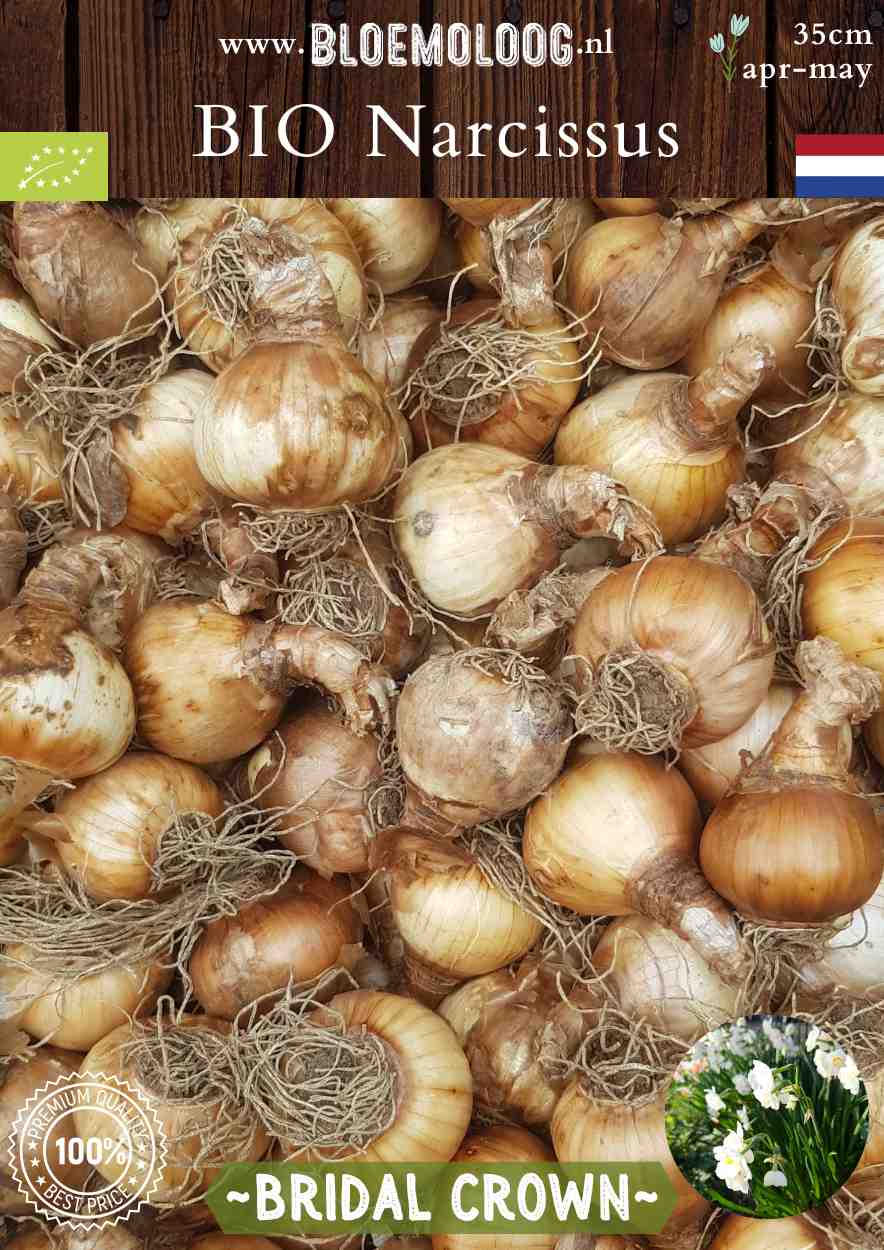Bloemoloog
Organic Narcissus 'Bridal Crown' - Bridal crown | 7 pcs.
Organic Narcissus 'Bridal Crown' - Bridal crown | 7 pcs.
Estimated Shipping Widget will be displayed here!
Couldn't load pickup availability
Organic cluster daffodils
The Narcissus 'Bridal Crown' is a bicoloured, double-flowered cluster daffodil with shiny cream-coloured petals and a light orange centre. It grows to about 35 centimeters high with several bluish-green flower stems per bulb and narrow long leaves with the flowers still above and has several small double flowers on a flower stem. She is an early flowering daffodil that blooms for about 3 weeks in the period March and April.
She is very suitable as a cut flower, she smells fantastic!
Combine the 'Bridal Crown' with Tulipa 'Novi Sun' or Ornithogalum 'White Trophy'.
How, where and when do I plant a daffodil bulb?
An organic daffodil flowerbulb needs a cold period, so plant it in the ground from September to January. The planting depth is 2 to 3 times the height of the flowerbulb itself and the planting distance is 2 to 3 times the width of the flowerbulb itself.
In the case of pot planting, the flowerbulbs may be planted closer together and may be half above the ground for decoration. After flowering, the flowerbulbs should be planted back in the garden with the planting depth and spacing discussed above.
Plant the daffodil 'Bridal Crown' in a sunny to semi-shaded spot in the garden, pot or lawn. Plant it in groups in a nutrient-rich, water-permeable, preferably calcareous, sandy soil, but it will also grow in clay soil. As long as the soil is well-drained and does not retain excess water. If you have clay soil, you can improve the soil by adding organic matter such as compost or well-rotted manure to improve drainage.
Daffodil bulbs are poisonous, which is why they are avoided by rodents such as voles. Use them as a natural protection for other flowerbulbs by planting them around and between the other bulbs.
Care of the daffodil
Provide organic nutrition during planting. Cut off the spent flowers at the top and let the rest of the foliage die. Only cut it off when the leaf has completely dried out. The Narcissus 'Bridal Crown' is a strong species that naturalizes well, it faithfully returns every year. Provide organic food annually for optimal results.
We recommend Bio Kultura for organic potting soil, plant food and other soil improvers!
Propagation
For propagation, the flower bulb can be dug out at the beginning of summer. The flower bulb is dried and stored in a warm place. They can be planted again from September. Plant the small bulbs separately and provide organic nutrition so that the small flower bulbs grow quickly.
Buy Organic Narcissus 'Bridal Crown'
Skal NL-BIO-01 certified: 109459
Packed per 7 flower bulbs or choose a stacking discount!
Stacking discount: D
Can be ordered from June '25!
EU shipping €8.95 - Free shipping from €100 purchase.
Characteristics
| Flowering time: | April - May |
| Planting time: | From September |
| Planting depth: | 10 cm deep |
| Planting distance: | 10 cm apart |
| Height: | 35 cm high |
| Flower diameter: | 10 cm wide |
| Location: | Partial shade, sun |
| Soil PH: | Clay, loam, sandy soil - Slightly acidic/neutral |
| Winter hardiness: | Good hardy |
| Propagation: | Good (naturalizes) |
| Origin: | Western Europe |
| Family: | Amaryllidaceae (daffodil family) |
| Colour: | Cream with orange heart |
| Bee-friendly: | No |
| Fragrant: | Yes |
| Bulb size: | 12/14 |
Other daffodil varieties

NL-BIO-01
To share












